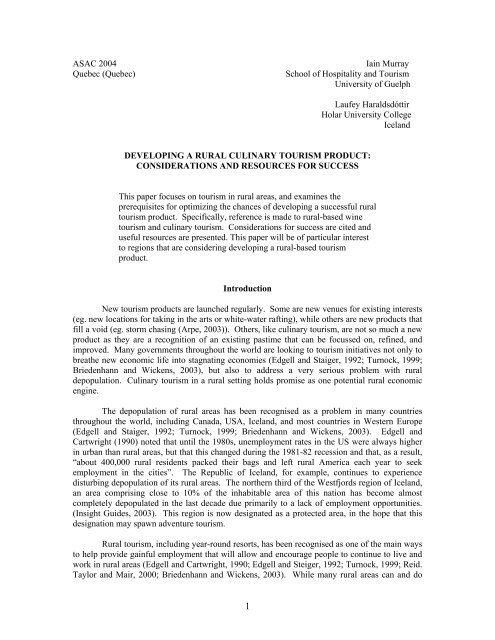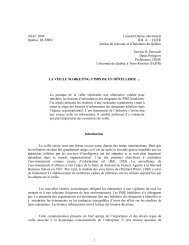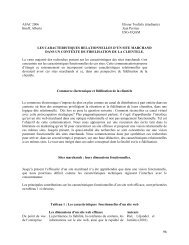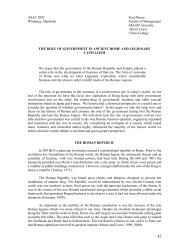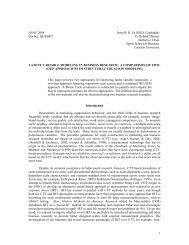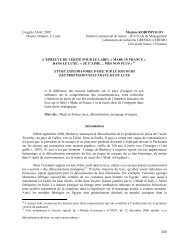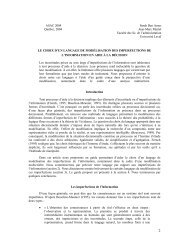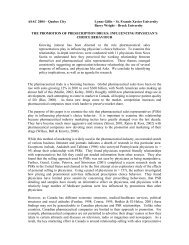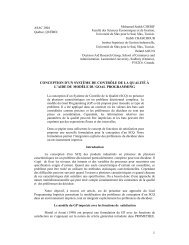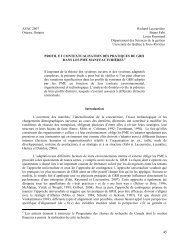ASAC 2004 Iain Murray Quebec (Quebec) School of Hospitality and ...
ASAC 2004 Iain Murray Quebec (Quebec) School of Hospitality and ...
ASAC 2004 Iain Murray Quebec (Quebec) School of Hospitality and ...
You also want an ePaper? Increase the reach of your titles
YUMPU automatically turns print PDFs into web optimized ePapers that Google loves.
<strong>ASAC</strong> <strong>2004</strong><br />
<strong>Quebec</strong> (<strong>Quebec</strong>)<br />
<strong>Iain</strong> <strong>Murray</strong><br />
<strong>School</strong> <strong>of</strong> <strong>Hospitality</strong> <strong>and</strong> Tourism<br />
University <strong>of</strong> Guelph<br />
Laufey Haraldsdóttir<br />
Holar University College<br />
Icel<strong>and</strong><br />
DEVELOPING A RURAL CULINARY TOURISM PRODUCT:<br />
CONSIDERATIONS AND RESOURCES FOR SUCCESS<br />
This paper focuses on tourism in rural areas, <strong>and</strong> examines the<br />
prerequisites for optimizing the chances <strong>of</strong> developing a successful rural<br />
tourism product. Specifically, reference is made to rural-based wine<br />
tourism <strong>and</strong> culinary tourism. Considerations for success are cited <strong>and</strong><br />
useful resources are presented. This paper will be <strong>of</strong> particular interest<br />
to regions that are considering developing a rural-based tourism<br />
product.<br />
Introduction<br />
New tourism products are launched regularly. Some are new venues for existing interests<br />
(eg. new locations for taking in the arts or white-water rafting), while others are new products that<br />
fill a void (eg. storm chasing (Arpe, 2003)). Others, like culinary tourism, are not so much a new<br />
product as they are a recognition <strong>of</strong> an existing pastime that can be focussed on, refined, <strong>and</strong><br />
improved. Many governments throughout the world are looking to tourism initiatives not only to<br />
breathe new economic life into stagnating economies (Edgell <strong>and</strong> Staiger, 1992; Turnock, 1999;<br />
Briedenhann <strong>and</strong> Wickens, 2003), but also to address a very serious problem with rural<br />
depopulation. Culinary tourism in a rural setting holds promise as one potential rural economic<br />
engine.<br />
The depopulation <strong>of</strong> rural areas has been recognised as a problem in many countries<br />
throughout the world, including Canada, USA, Icel<strong>and</strong>, <strong>and</strong> most countries in Western Europe<br />
(Edgell <strong>and</strong> Staiger, 1992; Turnock, 1999; Briedenhann <strong>and</strong> Wickens, 2003). Edgell <strong>and</strong><br />
Cartwright (1990) noted that until the 1980s, unemployment rates in the US were always higher<br />
in urban than rural areas, but that this changed during the 1981-82 recession <strong>and</strong> that, as a result,<br />
“about 400,000 rural residents packed their bags <strong>and</strong> left rural America each year to seek<br />
employment in the cities”. The Republic <strong>of</strong> Icel<strong>and</strong>, for example, continues to experience<br />
disturbing depopulation <strong>of</strong> its rural areas. The northern third <strong>of</strong> the Westfjords region <strong>of</strong> Icel<strong>and</strong>,<br />
an area comprising close to 10% <strong>of</strong> the inhabitable area <strong>of</strong> this nation has become almost<br />
completely depopulated in the last decade due primarily to a lack <strong>of</strong> employment opportunities.<br />
(Insight Guides, 2003). This region is now designated as a protected area, in the hope that this<br />
designation may spawn adventure tourism.<br />
Rural tourism, including year-round resorts, has been recognised as one <strong>of</strong> the main ways<br />
to help provide gainful employment that will allow <strong>and</strong> encourage people to continue to live <strong>and</strong><br />
work in rural areas (Edgell <strong>and</strong> Cartwright, 1990; Edgell <strong>and</strong> Steiger, 1992; Turnock, 1999; Reid.<br />
Taylor <strong>and</strong> Mair, 2000; Briedenhann <strong>and</strong> Wickens, 2003). While many rural areas can <strong>and</strong> do<br />
1
<strong>of</strong>fer tourism activities ranging from wildlife viewing <strong>and</strong> bird watching to hiking <strong>and</strong> horseback<br />
riding, the potential to cross-market <strong>and</strong> package these products with culinary tourism is almost<br />
completely unexplored. Providing leadership in this potential however is the Canadian Tourism<br />
Commission (CTC 2003a; Wolfe 2003).<br />
Wine tourism, which is predominantly a rural product, yet attracts aficionados <strong>of</strong> both<br />
food <strong>and</strong> wine, can <strong>of</strong>fer significant guidance in developing a rural-based culinary tourism<br />
product in a region that is blessed with a richness <strong>of</strong> farming activity, but not so fortunate to be<br />
able to produce wine. The tourism board <strong>of</strong> Queensl<strong>and</strong>, Australia described wine tourism as “a<br />
wide range <strong>of</strong> experiences built around visitation to wineries <strong>and</strong> wine regions” including the<br />
tasting <strong>of</strong> wine <strong>and</strong> food, <strong>and</strong> the enjoyment <strong>of</strong> regional environs (Queensl<strong>and</strong> Government<br />
Department <strong>of</strong> State Development, <strong>2004</strong>). Wolfe (2003) defined the culinary tourist as one who<br />
travels in order to find <strong>and</strong> enjoy prepared food <strong>and</strong> drink. To suggest that the successful<br />
examples <strong>of</strong> “wine tourism” in several regions <strong>of</strong> Australia, plus the Napa Valley in California,<br />
<strong>and</strong> the Niagara Region in Canada, could not be extrapolated to non-wine-producing farming<br />
regions would be to overlook a significant potential area for growth in rural-based tourism. The<br />
argument is that while travellers’ interest in wine-growing is indisputable, the potential number <strong>of</strong><br />
travellers who may be interested in gastronomy <strong>and</strong> wine is even more substantial than the<br />
number interested in wine alone. Wolf (2003) noted that “Eating <strong>and</strong> drinking are universal<br />
activities to which we can all relate”. Boniface (2003) not only stated that “food is a global<br />
language”, but also emphasized the same belief as the Queensl<strong>and</strong> State Government when she<br />
wrote that food eaten in interesting places is more appealing than food eaten at home.<br />
This paper draws on the literature that explores wine <strong>and</strong> culinary tourism products, <strong>and</strong><br />
<strong>of</strong>fers several considerations for developing a new culinary tourism initiative in a rural region.<br />
Rural Tourism / Culinary Tourism<br />
“Rural tourism” is not a positive term for many travellers. As Davidson (1992) stated,<br />
“rural tourism came to be synonymous with ‘cheap tourism’, an economical alternative for<br />
those who could not afford to follow the annual mass migrations to the beaches”.<br />
Additionally, Davidson noted: “perhaps the greatest fear <strong>of</strong> city dwellers, regarding the<br />
countryside, is that <strong>of</strong> being bored”. The Ontario Rural Tourism Council (2001) expressed<br />
similar unease with the label “rural tourism”, <strong>and</strong> suggested that a different adjective needed<br />
to be found (under consideration was the word “countryside”). While the term “rural” may be<br />
inconsequential to tourism businesses, academics <strong>and</strong> researchers communicating among<br />
themselves, it may be wise to avoid the term in any communication such as marketing or<br />
advertising with consumers.<br />
Although travellers have, for millennia, criss-crossed the planet looking for foodstuffs to<br />
trade, the term “culinary tourism” is relatively new, <strong>and</strong> is attributed to Lucy Long from an article<br />
she authored in 1998 (Wolfe 2003). Clearly, as a tourism product, it is relatively new, <strong>and</strong> by<br />
extension, reliable data is scarce.<br />
Despite the concern over the adjective “rural”, it is well-known that city-dwellers want to<br />
get out into the country <strong>and</strong> onto farms (Edgell <strong>and</strong> Cartwright, 1990; Edgell <strong>and</strong> Steiger, 1992;<br />
Turnock, 1999), <strong>and</strong> although culinary tourism is <strong>of</strong>ten thought <strong>of</strong> as an urban experience in fivestar<br />
restaurants, this is far from being an accurate depiction <strong>of</strong> its potential. True food aficionados<br />
seek out memorable gastronomic experiences at venues ranging from five-star restaurants to<br />
unpretentious, <strong>and</strong> relatively unknown, small-town cafés, <strong>and</strong> even farmers’ markets. The only<br />
real ‘non-starter’ tends to be chain restaurants (Wolfe 2003).<br />
2
Although there is a tendency to think <strong>of</strong> culinary tourism in terms <strong>of</strong> fine dining <strong>and</strong><br />
wineries, as noted previously, such a narrow approach would clearly limit thinking about rural<br />
culinary tourism products. A recent comprehensive study <strong>of</strong> culinary tourism in Canada (CTC<br />
2003a), which is cited as “one <strong>of</strong> the most comprehensive pr<strong>of</strong>iles yet available <strong>of</strong> culinary<br />
tourists” (Wolf 2003), found that 1.8 million Canadian adults (8% <strong>of</strong> the adult population) are<br />
“wine <strong>and</strong> culinary enthusiasts”. This study also identified that these enthusiasts are more<br />
affluent (almost 20% higher household income) <strong>and</strong> have more education, than the average<br />
Canadian tourist. Wolf (2003) suggested that culinary tourists, in addition to seeking out venues<br />
for prepared food <strong>and</strong> drink, tend to be the type <strong>of</strong> people who like to ‘explore’ <strong>and</strong> will even<br />
make a point <strong>of</strong> seeking out the location where a favourite product is made. Examples such as the<br />
Hershey chocolate factory <strong>and</strong> visitor centre in the somewhat rural area <strong>of</strong> Smiths Falls Ontario,<br />
suggests that Wolf’s observation is correct.<br />
Interest in ‘things culinary’ that may apply to tourists is certainly evident <strong>and</strong> gaining<br />
momentum. There are Web sites for the Slow Food Movement, a mapped out self-drive route for<br />
gastronomic experiences in the Charlevoix region <strong>of</strong> <strong>Quebec</strong> Canada (“Route des Saveurs de<br />
Charlevoix”), <strong>and</strong> the “Taste <strong>of</strong> Scotl<strong>and</strong>” Web site that is aimed at enticing tourists to come <strong>and</strong><br />
enjoy the restaurants <strong>of</strong> Scotl<strong>and</strong>, to name just a few (www.slowfood.com,<br />
www.bonjourquebec.com , www.taste-<strong>of</strong>-scotl<strong>and</strong>.com). In addition, there are Web sites aimed<br />
primarily at academics <strong>and</strong> businesses that are interested in culinary tourism, examples <strong>of</strong> which<br />
include the International Culinary Tourism Association, <strong>and</strong> the European Network <strong>of</strong> Regional<br />
Culinary Heritage (www.culinarytourism.com , www.culinaryheritage.com).<br />
Hall <strong>and</strong> colleagues have conducted extensive investigation into wine <strong>and</strong> food tourism in<br />
Australia (Hall, Cambourne, Marcionis, <strong>and</strong> Johnson 1997; Hall 2002; Hall <strong>2004</strong>), <strong>and</strong> identified<br />
numerous issues such as government involvement, organizational networks <strong>and</strong> clusters (see also<br />
Briedenhann <strong>and</strong> Wickens, 2003), the need for “champions” (leadership), linkages <strong>and</strong><br />
collaborative behaviour amongst organizations, entrepreneurial culture, <strong>and</strong>, specifically, the need<br />
for wineries to see themselves as part <strong>of</strong> the larger tourism industry. Reid et al (2000) conducted<br />
extensive research into rural tourism in southwestern Ontario, Canada, <strong>and</strong> found, among other<br />
issues, that community-based planning was sorely lacking, <strong>and</strong> proving to be a critical issue to<br />
successful rural tourism development. Boniface (2003) also identified many issues related to<br />
wine <strong>and</strong> culinary tourism in her book “Tasting Tourism: Travelling for Food <strong>and</strong> Drink”. She<br />
noted that the potential capacity for what she refers to as “food <strong>and</strong> drink tourism” to regenerate<br />
rural areas is so significant that it brings it into the political domain. This is a key observation.<br />
Boniface (2003) clearly is <strong>of</strong> the view that culinary tourism is by no means limited to<br />
urban regions <strong>and</strong> five-star restaurants. She lists farms, farm shops, fruit-picking sites, cheese<br />
manufacturers, honey producers, processors <strong>of</strong> foods such as jams <strong>and</strong> chocolate, cafés, tea<br />
rooms, <strong>and</strong> bars among potential sites in the domain <strong>of</strong> food <strong>and</strong> drink tourism, <strong>and</strong> suggests that<br />
“local” <strong>and</strong> “artisan production” are key words in the product. “The modest local establishment<br />
appeals [to the food tourist] due to …authenticity…”. As an example, she points to the popularity<br />
<strong>of</strong> afternoon tea with tourists in Engl<strong>and</strong>, despite the fact that locals now prefer c<strong>of</strong>fee. Boniface,<br />
as did Hall, noted that critical mass is important, especially in a rural setting, as the traveller is<br />
expecting an adequately time-filling, as well as satisfying, proposition.<br />
3
Six Considerations for Launching a New Rural Culinary Tourism Product<br />
It is clear that there are certain criteria that can help to ensure the success <strong>of</strong> a rural<br />
culinary tourism product. These criteria are drawn from a review <strong>of</strong> the literature, <strong>and</strong>, although<br />
primarily mentioned in relation to wine tourism initiatives, should serve well for a rural-based<br />
culinary initiative.<br />
Multiple Players<br />
The notion <strong>of</strong> “critical mass”, as previously mentioned, cuts at least two ways. First, as<br />
Boniface (2003) suggested, there must be enough for the tourist to do to fill his or her time in a<br />
meaningful way. Secondly, if a rural region wants to develop a product that will attract repeat<br />
visitors, <strong>and</strong> not become a “been there done that” location that quickly enters the decline stage <strong>of</strong><br />
the product life cycle, then there will be a need for not only multiple food <strong>and</strong> drink venues, but<br />
complimentary products such as lodging, outdoor activities, <strong>and</strong>, ideally, an educational<br />
component as well (Boniface 2003; Ontario Travel, <strong>2004</strong>). Clearly, it would be extremely<br />
difficult for a single business or organization to create a meaningful <strong>and</strong> sustainable culinary<br />
tourism product. Even to get started, a rural initiative <strong>of</strong> any sort would have to be enticing<br />
enough to get travellers to leave the city <strong>and</strong> make the trek to the non-urban location.<br />
Briedenhann <strong>and</strong> Wickens (2003) noted the success <strong>of</strong> the European Cultural Routes with<br />
over 2000 partners working in cooperation on a chain <strong>of</strong> projects with shared information. Telfer<br />
(2000) suggested that the development <strong>of</strong> cluster relationships in the Niagara Region <strong>of</strong> Ontario,<br />
Canada has been significant in promotion <strong>of</strong> the “Tastes <strong>of</strong> Niagara” alliance <strong>of</strong> food producers,<br />
winemakers, chefs, restaurateurs, <strong>and</strong> retailers (Tastes <strong>of</strong> Niagara Quality Food Alliance, <strong>2004</strong>).<br />
(The reader will find an excellent discussion <strong>of</strong> network <strong>and</strong> cluster development in Hall 2002<br />
<strong>and</strong> Hall <strong>2004</strong>.) Reid, Mair, George, <strong>and</strong> Taylor (2001) present a comprehensive plan based on a<br />
cooperative community-based approach, for developing a rural tourism destination.<br />
Government Involvement<br />
There is agreement that government involvement in rural tourism initiatives is essential<br />
(Boniface 2003; Briedenhann <strong>and</strong> Wickens 2003; Wolfe 2003; Hall, <strong>2004</strong>). Hall (<strong>2004</strong>) noted the<br />
creation <strong>and</strong> funding <strong>of</strong> the Victoria Wineries Tourism Council (in the State <strong>of</strong> Victoria,<br />
Australia) in 1993, the establishment <strong>of</strong> the South Australia Wine Tourism Council in 1996, <strong>and</strong><br />
the development <strong>of</strong> a Food <strong>and</strong> Wine Tourism Plan in the State <strong>of</strong> New South Wales, each by<br />
their respective State governments. Conversely, he noted that New Zeal<strong>and</strong> is much less welldeveloped<br />
in wine tourism than Australia, <strong>and</strong> that where innovation <strong>and</strong> the creation <strong>of</strong> networks<br />
in wine <strong>and</strong> food tourism have occurred in New Zeal<strong>and</strong>, it has been due to individual champions<br />
working at the local level (Hall <strong>2004</strong>). Wolfe (2003) cited the Canadian Tourism Commission<br />
(CTC - a jointly government- <strong>and</strong> industry-funded partnership) as one <strong>of</strong> the “movers <strong>and</strong><br />
shakers” in the business <strong>of</strong> culinary tourism. In fact, the CTC has written “How-to guide:<br />
Develop a Culinary Tourism Product” (CTC 2003b).<br />
As noted previously, the potential for food <strong>and</strong> drink tourism to regenerate rural areas is<br />
so great that governments simply cannot afford to overlook it (Boniface, 2003). Given the<br />
taxation rates in many jurisdictions, plus the well-documented multiplier effects <strong>of</strong> tourism <strong>and</strong> its<br />
potential to generate foreign currency, it is not difficult to show a good return on investment for<br />
government support <strong>of</strong> tourism initiatives (Gedge, <strong>2004</strong>).<br />
4
Based on his research findings, Hall (<strong>2004</strong>) suggested that too many public<br />
administrative agencies within a region may actually hamper success, while the existence <strong>of</strong> a<br />
champion, <strong>and</strong> the hosting <strong>of</strong> meetings to develop relationships could figure significantly into<br />
successes <strong>of</strong> creating cooperative networks <strong>and</strong> clusters. In the same paper, Hall noted that the<br />
Australian Bureau <strong>of</strong> Industry Economics suggested that governments could potentially play the<br />
following roles in network development:<br />
• information dissemination<br />
• encouraging cooperation within industries<br />
• improve existing networks between public sector agencies <strong>and</strong> private companies<br />
• examine the effects <strong>of</strong> existing legislation on the formation, maintenance, <strong>and</strong> break-up <strong>of</strong><br />
networks.<br />
Cooperation <strong>and</strong> Trust<br />
The literature clearly emphasizes the need for cooperation among participating<br />
businesses, governments, <strong>and</strong> individuals. Unfortunately, there is also very clear indication that<br />
cooperation is difficult to achieve in practice ( Reid et al 2000; Briedenhann <strong>and</strong> Wickens, 2003;<br />
Hall <strong>2004</strong>). If a rural tourism initiative is to succeed however, then the need for, <strong>and</strong> the benefits<br />
<strong>of</strong>, cooperation must be clearly <strong>and</strong> indisputably presented to all potential participants. Rosenfeld<br />
(1997) noted that in order for groups <strong>of</strong> operators to work successfully together, there must be<br />
“…reciprocity <strong>and</strong> sufficient levels <strong>of</strong> trust to encourage pr<strong>of</strong>essional interaction <strong>and</strong><br />
collaborative behaviour”.<br />
In his research, unfortunately, Hall (<strong>2004</strong>) noted that while tourism operators tend to be<br />
quite positive towards the wine <strong>and</strong> food industries, the same is not true <strong>of</strong> the wine <strong>and</strong> food<br />
industries towards the tourism industry. Wineries <strong>and</strong> food producers, such as cheese-makers, did<br />
not see themselves as being part <strong>of</strong>, nor having any reason to be interested in, the tourism industry<br />
or tourists.<br />
The message for rural tourism initiatives, therefore, is that farmers, producers,<br />
restaurateurs, artisans <strong>and</strong> others must come to see themselves as part <strong>of</strong>, <strong>and</strong> benefiting from, the<br />
broader tourism industry. Clearly, this is no small task, <strong>and</strong> champions (see below) have a<br />
responsibility to promote both the economic <strong>and</strong> social benefits <strong>of</strong> the formation <strong>of</strong> cooperative<br />
relationships between a wide variety <strong>of</strong> businesses.<br />
Champion (Leadership)<br />
A major potential stumbling block to rural tourism initiatives is the absence <strong>of</strong> a<br />
champion, <strong>and</strong> continuity in this leadership (Hall, 2002, <strong>2004</strong>). Major long-term initiatives tend<br />
to fail when leadership is either lacking or inconsistent. Such initiatives need to have one person<br />
take the leadership role <strong>and</strong> stick with it for the long term. In order to help ensure that this<br />
happens, the ‘players’ <strong>and</strong> the champion both need to commit to the project for several years <strong>and</strong><br />
provide the support necessary to give the initiative a reasonable chance at being successful.<br />
While the presence <strong>of</strong> a champion may be somewhat less important to the establishment<br />
<strong>of</strong> a culinary centre in an urban area, it is an “essential” for the establishment <strong>of</strong> a culinary centre<br />
in a rural area. As mentioned above under cooperation <strong>and</strong> trust, if a rural culinary tourism<br />
initiative is to be successful, then ‘players’ who would not normally consider tourism as having<br />
anything to do with them, much less any benefit to them, must be clearly shown the economic<br />
connection. Just as wineries do not see themselves as being a part <strong>of</strong> the tourism industry (Hall<br />
5
<strong>2004</strong>), undoubtedly the same will be true for most farmers <strong>and</strong> food producers <strong>and</strong> processors.<br />
There are, however, exceptions that can provide excellent examples for others. In Australia,<br />
numerous wineries have developed extensive tourism facilities (Hall 2002). In Icel<strong>and</strong>, the<br />
Icel<strong>and</strong>ic Farm Holiday Association has grown from 5 members <strong>and</strong> 330 guest-nights in 1970<br />
(the original “farm-stay” concept) to 124 members in 2003 with over 3200 beds (Viktorsdóttir,<br />
2003).<br />
In the successful creation <strong>of</strong> food <strong>and</strong> wine tourism networks <strong>and</strong> associated new<br />
products in New Zeal<strong>and</strong>, the roles <strong>of</strong> a champion <strong>and</strong> local government were identified as being<br />
singularly especially important (Hall <strong>2004</strong>). The creation <strong>of</strong> the Hawkes Bay (New Zeal<strong>and</strong>)<br />
Wine <strong>and</strong> Food Group was the result <strong>of</strong> several local leaders recognizing that the creation <strong>of</strong> a<br />
critical <strong>and</strong> connected mass was needed in order to generate sufficient visitors to make their<br />
respective businesses successful. In contrast, Briedenhann <strong>and</strong> Wickens (2003) noted that<br />
tourism promotion in South Africa has been significantly frustrated by unilateral action,<br />
uncoordinated programs, duplication <strong>of</strong> effort <strong>and</strong> squ<strong>and</strong>ering <strong>of</strong> resources.<br />
Related to both trust <strong>and</strong> the need for a champion, was Hall’s observation regarding<br />
credibility:<br />
“Critical to the development <strong>of</strong> the [Hawkes Bay] Food <strong>and</strong> Wine Group was the<br />
involvement <strong>of</strong> ‘experts’ or ‘knowledge brokers’ at the initial meeting who could<br />
provide what was perceived as ‘independent’ advice which created a climate <strong>of</strong><br />
trust between potential members <strong>of</strong> the cluster, <strong>and</strong>, just as importantly, allowed<br />
the work <strong>of</strong> champions to be perceived as wider than self interest in the creation<br />
<strong>of</strong> the group.” (Hall <strong>2004</strong>).<br />
Long-Term Approach <strong>and</strong> Funding<br />
Any major initiative will not come to fruition in a short period <strong>of</strong> time. As the<br />
experiences in Australia <strong>and</strong> New Zeal<strong>and</strong> have shown (Hall <strong>2004</strong>), it will take several years to<br />
develop the product <strong>and</strong> the market, <strong>and</strong> the ‘players’ must buy into this notion (Briedenhann <strong>and</strong><br />
Wickens, 2003). Not surprisingly, this is related to the lack <strong>of</strong> continued long-term leadership (a<br />
champion).<br />
This initiative will require some funding for at least two things: a “champion” (leader) to<br />
develop <strong>and</strong> promote the initiative, <strong>and</strong> an advertising budget. Briedenhann <strong>and</strong> Wickens (2003)<br />
noted that in the highly ambitious “African Dream” project to create rural tourism routes in South<br />
Africa, funding was cited as “the only acute problem thus far”.<br />
Essential Resources for a Rural Culinary Tourism Initiative<br />
It has been noted that even the term “culinary tourism” is relatively new <strong>and</strong> that<br />
research, information, data, <strong>and</strong> resources are relatively scarce on the topic. However, as a result<br />
<strong>of</strong> this exploratory research paper, several resources that may prove very valuable to any group<br />
looking into actually establishing a rural tourism initiative have been assembled. While all <strong>of</strong><br />
these are included in the list <strong>of</strong> references, not all references would be particularly useful in the<br />
process <strong>of</strong> starting such an initiative. It is also likely that some useful resources, regrettably <strong>and</strong><br />
inadvertently, may have been overlooked to date.<br />
6
Books<br />
Among the ‘must-read’ books are “Tasting Tourism: Travelling for Food <strong>and</strong> drink by<br />
Priscilla Boniface. While not an easy-to-read book, it has a wealth <strong>of</strong> excellent ideas <strong>and</strong><br />
information that is useful <strong>and</strong> thought-provoking. A second book, although not reviewed for this<br />
paper due to lack <strong>of</strong> availability at the time, is “Food Tourism Around the World: Development,<br />
Management <strong>and</strong> Markets” (Hall, C.M., Sharples, E., Mitchell, R., Cambourne, B., <strong>and</strong> Macionis,<br />
N (eds) (2003); published by Butterworth-Heinemann, Oxford; ISBN 0750 65466 X) This is<br />
likely to be an excellent resource due in part, to the involvement <strong>of</strong> C. Michael Hall.<br />
Manuals <strong>and</strong> Reports<br />
The manual published by the Canadian Tourism Commission, “How-to guide: Develop a<br />
Culinary Tourism Product” (see reference list; ISBN 0-662-35076-6; quote #C50300E when<br />
ordering by email) should be obtained <strong>and</strong> reviewed by anyone working in this area. This<br />
publication, which is also available in French, can be ordered on-line through email to<br />
distribution@ctc-cct.ca. Available through the same channel, is the CTC’s “Canadian Wine <strong>and</strong><br />
Culinary Enthusiasts: A Special Analysis <strong>of</strong> the Travel Activities <strong>and</strong> Motivation Survey<br />
(TAMS)” (see reference list; ISBN 0-662-33867-7; quote #C50174E when ordering by email).<br />
This publication provides useful statistics about the pr<strong>of</strong>ile <strong>of</strong> Canadian wine <strong>and</strong> culinary<br />
enthusiasts, <strong>and</strong> these statistics will be <strong>of</strong> interest to others who may want to investigate the<br />
pr<strong>of</strong>ile <strong>of</strong> such enthusiasts in a different country. Both <strong>of</strong> these publications are new in 2003.<br />
Two publications from the University <strong>of</strong> Guelph in Ontario Canada will be very useful.<br />
The first is “Rural Tourism Development: Research Report”, by Reid, Taylor, <strong>and</strong> Mair (see<br />
reference list). The second is “Visiting your Future: A Community’s Guide to Planning Rural<br />
Tourism, by Reid, Mair, George, <strong>and</strong> Taylor (see reference list).<br />
Erik Wolf, director <strong>of</strong> the International Culinary Tourism Association has written<br />
“Culinary Tourism: A Tasty Economic Proposition”. This paper is available through email from<br />
info@culinarytourism.org . In 37 pages, it provides background, economic potential, <strong>and</strong> issues<br />
to establishing a culinary tourism venue.<br />
Conclusions<br />
This paper is the result <strong>of</strong> preliminary research into how to go about actually establishing<br />
a rural culinary tourism product in northern Icel<strong>and</strong>. The information presented here has been<br />
very useful in getting the Icel<strong>and</strong> project underway <strong>and</strong>, hopefully, will be <strong>of</strong> value to others<br />
working in the area <strong>of</strong> rural tourism, especially with a culinary emphasis.<br />
The Icel<strong>and</strong> project is on-going at the time <strong>of</strong> writing, <strong>and</strong> the authors see a follow-up<br />
article detailing specific issues related to the project. The goal is to have a recognized, viable <strong>and</strong><br />
sustainable culinary tourism product in northern Icel<strong>and</strong> within a few years. The first steps will<br />
be operating in summer <strong>2004</strong>.<br />
7
References<br />
Briedenhann, J. <strong>and</strong> Wickens, E. (2003). “Tourism routes as a tool for the economic development<br />
<strong>of</strong> rural areas- vibrant hope or impossible dream?” Tourism Management (in press, available online<br />
04 Jun 2003.<br />
Canadian Tourism Commission (2003a). Canadian Wine <strong>and</strong> Culinary Enthusiasts. A Special<br />
Analysis <strong>of</strong> the Travel Activities <strong>and</strong> Motivation Survey (TAMS). CTC Ottawa, Canada.<br />
Canadian Tourism Commission (2003b). How-to guide: Develop a culinary Tourism Product.<br />
CTC. Ottawa, Canada. November 2003.<br />
Edgell, D.L., <strong>and</strong> Cartwright, M.L. (1990). “How one Kansas town used tourism to revitalize its<br />
economic base.” Business America. 111:21 05 Nov 1990<br />
Edgell, D.L, <strong>and</strong> Staiger, L (1992). “A small community adopts tourism as a development tool.”<br />
Business America. 113(8)16. 20 Apr 92.<br />
Gedge, P. (<strong>2004</strong>). Vice-President-Marketing, Canadian Tourism Commission. Personal<br />
communication. 03 February <strong>2004</strong>.<br />
George, C., “A Cool Spa,” The Toronto Star (Travel Section) (03 May 2003). L-11.<br />
Hall, C.M., Cambourne, B., Macionis, N., <strong>and</strong> Johnson, G., (1997). “Wine Tourism <strong>and</strong> Network<br />
Development in Australia <strong>and</strong> New Zeal<strong>and</strong>: Review, Establishment <strong>and</strong> Prospects”,<br />
International Journal <strong>of</strong> Wine Marketing, 9(2/3), 5-31.<br />
Hall, C.M. (2002). Local Initiatives for Local Regional Development: The Role <strong>of</strong> Food, Wine,<br />
<strong>and</strong> Tourism. The 2 nd Tourism Industry & Education Symposium, Tourism <strong>and</strong> Well-Being.<br />
Arola, J., <strong>and</strong> Siitari, M. eds. Finl<strong>and</strong>.<br />
Hall, C.M. (<strong>2004</strong>). “Small Firms <strong>and</strong> wine <strong>and</strong> food tourism in New Zeal<strong>and</strong>: Issues <strong>of</strong><br />
collaboration, clusters <strong>and</strong> Lifestyles.” in Small Firms in Tourism: International Perspectives,<br />
Thomas, R, (ed) Elsevier, Oxford.<br />
Ontario Rural Tourism Council. (2002). Beyond the City Lights: Visioning Session. Regional<br />
Conferences. ORTC.<br />
Ontario Travel www.ontariotravel.net<br />
(www.ontariotravel.net/TcisCtrl?site=consumers&key1=experiences&key2=Culinary&language<br />
=EN&linkType=I)<br />
Reid, D.G., Taylor, J., <strong>and</strong> Mair, H., Rural Tourism Development: Research Report. Guelph,<br />
Ontario. <strong>School</strong> <strong>of</strong> Rural Planning <strong>and</strong> Development, University <strong>of</strong> Guelph, 2000.<br />
Reid, D.G., Mair, H., George, W., <strong>and</strong> Taylor, J., Visiting Your Future: A Community’s Guide to<br />
Planning Rural Tourism. Guelph, Ontario. Ontario Ministry <strong>of</strong> Agriculture, Food, <strong>and</strong> Rural<br />
Affairs. 2001.<br />
Rosenfeld, S.A. (1997) “Bringing business clusters into the mainstream <strong>of</strong> economic<br />
development”. European Planning Studies. 5(1)3-23.<br />
8
Tastes <strong>of</strong> Niagara Quality Food Alliance (<strong>2004</strong>)<br />
http://niagara.cioc.ca/details.asp?RSN=5144&Number=3 accessed February 13, <strong>2004</strong>.<br />
Telfer, D.J. (2000). “The Northeast Wine route: Wine Tourism in Ontario Canada <strong>and</strong> New York<br />
State” , in C.M. Hall, E. Sharples, B. Cambourne an N. Macionis (eds) Wine Tourism Around the<br />
World: Development, Management, <strong>and</strong> Markets, Oxford: Butterworth-Heinemann.<br />
Turnock, D. (1999). “Sustainable rural tourism in the Romanian Carpathians”. The Geographical<br />
Journal 165(2) 192.<br />
Viktorsdóttir, E.B. (2003). Rural tourism in Icel<strong>and</strong>: Technical information <strong>and</strong> data from<br />
Icel<strong>and</strong>ic Farm Holidays.Unpublished paper, available via email from ifh@farmholidays.is<br />
Wolf, E. (2003). Culinary Tourism: A Tasty Economic Proposition. (available on website<br />
www.culinarytourism.org; received electronically from the author on 22 Jan 04).<br />
9


